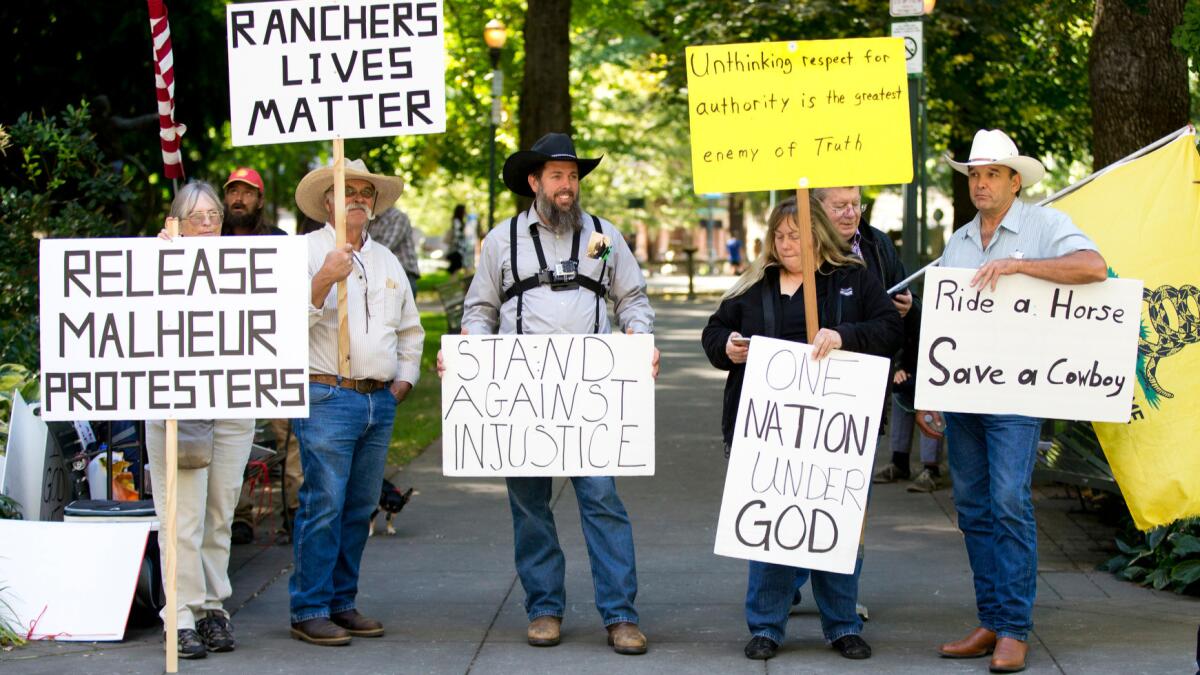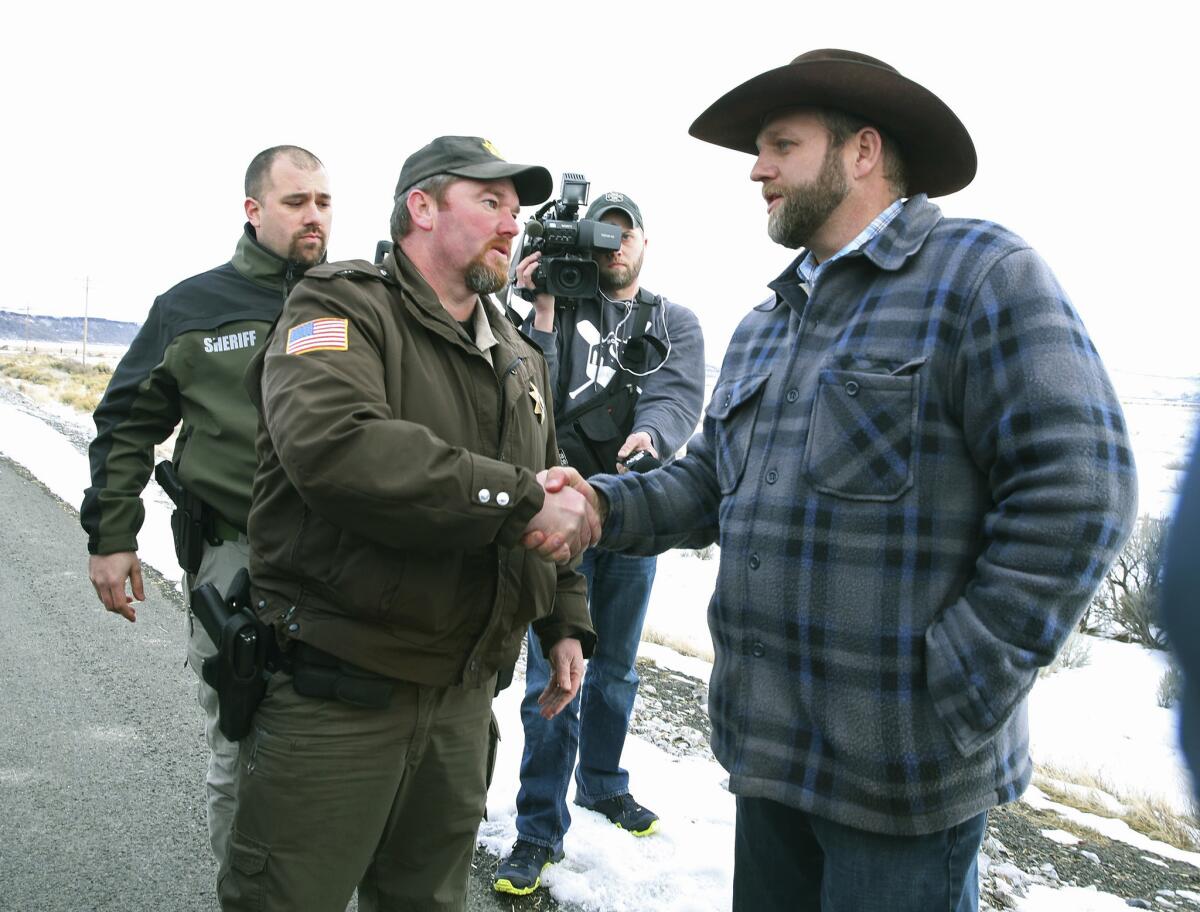Oregon sheriff describes takeover of wildlife refuge as far from peaceful

- Share via
Reporting from PORTLAND, Ore. — The takeover of a federal wildlife refuge in Oregon by anti-government protesters wasn’t violent, a county sheriff testified, but it was far from peaceful.
“Certainly it’s not normal to have a hundred people walking around with firearms on our streets,” Harney County Sheriff Dave Ward said Wednesday, becoming the first witness to testify in the trial of Ammon Bundy, his brother Ryan and five others charged with conspiracy in the 41-day takeover of a federal wildlife preserve in southeast Oregon.
Ward testified in the federal courthouse here that features a wall engraved with a quote from Thomas Jefferson: “The boisterous sea of liberty is never without a wave.” The sheriff told the jury how such a wave, ridden by Ammon Bundy and his supporters, came crashing down on Harney County early this year.
On Jan. 2, Ward was watching what he thought was a live TV feed of a Bundy-led rally just three blocks from his office in Burns. Outside the local Safeway, Bundy was urging the anti-government crowd — many from Idaho, Nevada and California — to join him in a seizure of the nearby Malheur National Wildlife Refuge, a 187,000-acre sanctuary for more than 300 bird species.

As a precaution, Ward had sent the inmates from the jail adjoining the sheriff’s office to another county and planned for his team to lock themselves into the heavy-walled slammer if they were attacked. He also had state troopers ready to back him up and figured the flag- and gun-waving out-of-towners would probably make a show of it and then depart.
Even so, “I had been feeling optimistic,” he said, that conflict could be avoided.
Then a deputy radioed in from 10 miles outside town. He’d just seen Bundy and several others drive by, apparently headed to the refuge. Ward realized that the video feed he had watched was on tape delay. The protesters were almost halfway to Malheur.
“It made the hair on the back of my neck go up.… Something was wrong,” the sheriff said.
Bundy and a caravan of followers moved swiftly once they arrived. They would later claim that their takeover of the federal land was legal and peaceful. Ward said it was neither.
“There’s 200 years of case law” contrary to the occupiers’ view that the U.S. land belonged to the people of Oregon, for whom they were claiming it, he said. A combat veteran, Ward said the takeover was done in military style. “What was described to me [by witnesses] was not peaceful but an armed room-clearing” of buildings controlled by the U.S. Fish and Wildlife Service.
That was the beginning of the standoff that ended in early February and resulted in one death, millions of dollars in damage, and the indictment of 26 people, 11 of whom have already negotiated pleas or been sentenced. At least one is scheduled to testify against his former occupation members.
Federal prosecutors are using considerable evidence, including videotapes provided by the defendants, who taped themselves during the standoff and held daily news briefings.
On Wednesday, the government played a video that had been put in the court exhibit record by the defense, showing Ward attempting to persuade Bundy and others to leave the refuge peacefully and try to work out their grievances through the system. Ward sounded sympathetic and said, for the most part, that he and Bundy usually had enjoyable conversations.
A number of times, however, Bundy or other protest leaders ended the talks with ultimatums. If he didn’t do as they asked, Ward was told, they said “they would bring hundreds of people to town to do my job for me,’” Ward testified.
He was also told, “We can’t control what they may or may not do,” he recounted. All that, the sheriff said, “in my mind, sounded bad.”
Bundy had told a reporter that if Burns townsfolk didn’t want them to stay at the refuge, they’d leave. A town hall meeting followed, in which a majority of the 400 or so attendees raised their hands in favor the occupiers departing. The news was passed on to protesters. They stayed anyway.
Bundy’s defense attorney, Marcus Mumford, pressed Ward on whether he thought the federal government had authority over its land in Oregon. Ward stood firm for the status quo, saying he’d spent considerable time researching the issue after first meeting with Bundy in November.
Ammon and Ryan Bundy, following the lead of their father, Cliven Bundy, 70, who is under indictment with two of his other sons in Nevada for a 2014 federal land takeover in a dispute over grazing fees, believe the U.S. has no right to regulate or own public land.
They brought their fight to Oregon, claiming that two local ranchers, Dwight and Steve Hammond, were wrongly sentenced to five years in prison for starting fires on federal land. They pressured Ward to prevent the Hammonds’ imprisonment and confront federal authorities.
When he refused, Ward became the target for the Bundys’ supporters, deluged with email and phoned-in threats and called a sellout — a point some tried to make by throwing coins at his front door, Ward said.
“Actually,” the sheriff testified, “I thought it was nice. We donated the coins to the local kids club.”
The trial is expected to last two months.
Anderson is a special correspondent.
ALSO
The $3.7-billion pipeline that became a rallying cry for tribes across America
Obama alternates a supportive message for Hillary Clinton with tough words for Donald Trump
The complicated immigration history of Melania Trump: Tourist visas, then work visas
More to Read
Sign up for Essential California
The most important California stories and recommendations in your inbox every morning.
You may occasionally receive promotional content from the Los Angeles Times.










